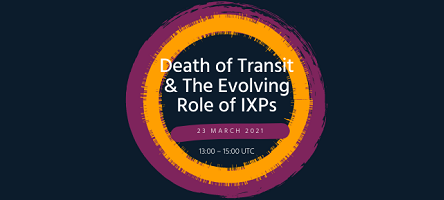
How are cloud and content delivery networks changing business models? How are global transit providers handling reduction in transit capacity? How are Internet Exchange Points making use of available opportunities?
These are some of the questions that were discussed in the ninth Virtual Peering Summit, that explored the death of transit and the evolving role of IXPs and other topics.

Patrick Christian, Principal Analyst at TeleGeography started the session with an outline of infrastructure rollout by major service providers and the exponential growth recorded over the past decade, particularly in content provider services.
Today, with traffic and demand increasing in different locations, data centers are expanding away from mature markets.
Growth of Data Centers
Between 2006 and 2015, an average of two new data centers were set up annually. The last four years has seen this increase to 15 new cloud regions annually with 28 in 2019 and 21 last year, a slight drop owing to the COVID-19 pandemic.
There are 43 others planned in the next two years, illustrating the demand for content providers.
At the same time, the largest demand comes from international capacity between data centers which makes submarine cable development a key focus for content providers.
This is why content providers like Google have been investing in their own undersea cable networks. Building independent cable networks is considered more cost effective than buying capacity from carriers. It also gives the companies more control over the capacity, landing and management of the cables.
Globally content provider networks account for 60 percent of international use bandwidth which is up a lot more than in 2010. Internet backbone providers are still recording healthy growth at over 22 per cent but it is dwarfed by content provider growth which averages 75 per cent.

Geoff Huston, Chief Scientist at the Asia Pacific Network Information Center, APNIC, explained that the trend actually goes back two decades ago when content providers were having a very hard time getting into markets.
Content providers tried negotiating with carriers a revenue share split but the latter opted to bill them instead. They then turned to advertising and the industry ballooned.
With massive new capital and stable revenue models, content providers are now kicking out the middleman by building their own cables.
Controlling the Network

Christian Kaufmann, Vice President at Akamai Technologies explained that one of the reasons the firm built its own backbone four years ago was to have more control over its network. Internet Service Providers(ISPs) previously held arbitrary power to charge whatever costs they wanted and sometimes failed to meet reliability and performance demands.
Kaufmann says the cost of hardware and deployment can be the biggest limitation to how extensive one can build their network. Companies are above all motivated by a return on investment and an infrastructure rollout has to make financial sense in that regard.

Mark Tinka, Head of Engineering at SEACOM says the region including countries like Singapore, Malaysia and Thailand started recording an uptake in Internet Protocol (IP) transit as more content firms lay out undersea cables.
Tinka says the same is happening today and the demand for IP transit to the continent will not go away. The IP traffic is still likely to remain but not at that inter-continental level, but more at a regional or national level.
The industry is likely to see a lot more growth, but at the same time devaluation in margins which will mean a huge potential for consolidation, which has the potential for going back to one or two monopolies and then the whole process begins again.
Kyle Spencer from Uganda’s Internet Exchange Point added that Internet exchanges can serve the same purpose they served of routing traffic between networks and markets before the advent of the exchange.
This might still be a small piece of the pie in the content world, but it may provide some sort of counter pressure for when the content guys become too aggregated and try to use their power.

Edrich De Lange, chair of INX-ZA in South Africa explained the challenges of getting providers to route some traffic through Durban at the onset of the exchange. After discussions and partnerships with local players, the exchange went from doing about 500mbs, to 20Gb today at peaks from local content alone.
Mark Tinka said ISPs and Internet Exchanges (IXs) are not going to die physically but will have to massively downsize due to the shrinked margins. When the traditional model of an exchange point starts to become less effective, other models will come out and put pressure on existing exchange point models as well as new entrants to adapt.
According to Geoff Huston, the world today is ruled by applications that are their own ecosystems. Users do not particularly care about the platforms or infrastructure the applications are running on and the money has similarly followed the applications.
This demand thinking up new business models to drive a world where applications define their own connectivity and communications irrespective of the local IXP, ISP or the local exchange.
Poll questions
1. How did you hear about this event
- 20% Social Media
- 45% Mailing List
- 24% Colleague or friend
- 5% AfPif website
- 6% other
2. Do you think the Internet industry’s evolution will have a positive impact on society?
- 80 Yes
- 6 No
- 15 Not sure
Threat from the skies
The real threat right now, and it is a threat, and it is going to get worse, comes from above. When folks like Space X start launching thousands of space crafts at a small altitude above the earth, the competition in spectrum and customers is not from the person in the office beside you doing the similar business model with terrestrial bases, the competition comes from the skies where if I can launch enough space craft at a low enough cost, my potential market is 7billion big.
And leadership in traditional infrastructure, to get away from traditional infrastructure; to see what customers are actually looking for. Leadership on how to shift form this culture to a new culture that provides users more value and keeps them more relevant and visible.